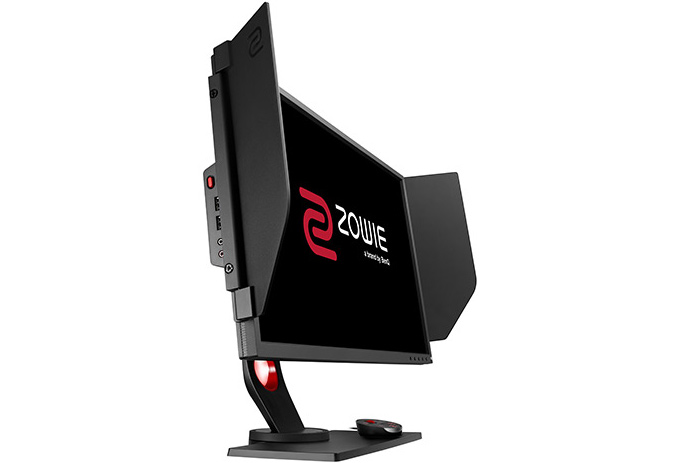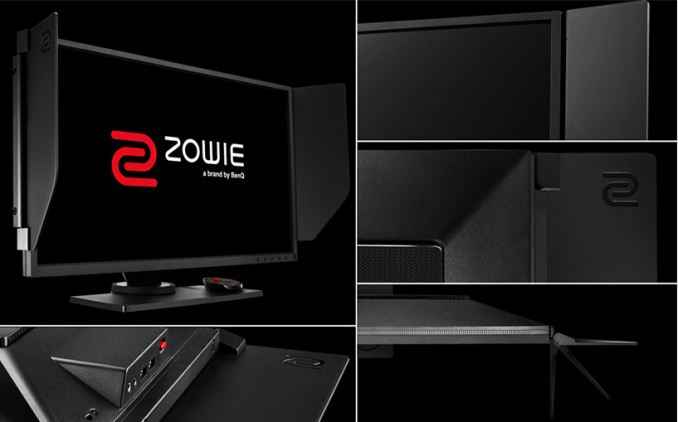BenQ Announces ZOWIE XL2546 ‘eSports’ Display: 24'', FHD, 240 Hz, DyAc ULMB Tech
by Anton Shilov on July 22, 2017 11:00 AM EST
BenQ this week introduced a new version of its ZOWIE XL2540 ultra-fast gaming display it launched last year. The improved device carrying the XL2546 model number has the same specifications as its predecessor, including a 1920×1080 resolution and a refresh rate as high as 240 Hz, but also adds BenQ’s proprietary DyAc (Dynamic Accuracy) technology designed to make fast-motion scenes a bit more clear.
The BenQ ZOWIE XL2540 monitor is one of the fastest gaming displays on the market today. The unit was launched in late 2016 and now BenQ launches its improved version, the ZOWIE XL2546 with DyAc. According to a preorder page at B&H, the new model mimics nearly the specs of the predecessor, then the new display features the same 24.5” TN panel from AU Optronics with a 1920×1080 resolution (it is the only 24" FHD panel with a 240 Hz refresh rate), supports for 16.7 million (6-bit + FRC) colors, has a typical contrast ratio for mainstream screens (1000:1), as well as offers a 320 cd/m2 brightness, which is lower compared to what the XL2540 offers (400 cd/m2). For some reason, with the ZOWIE XL2546, BenQ continues to ignore AMD’s FreeSync and NVIDIA’s G-Sync dynamic refresh rate technologies.
Two main features of the ZOWIE XL2546 display are its native 240 Hz refresh rate as well as the company’s DyAc (Dynamic Accuracy) technology that enhances the display's motion clarity. The manufacturer does not explain anything about this tech, but from various media reports (e.g., this one) it appears that the DyAc is BenQ's implementation of Ultra Low Motion Blur backlight strobing. ULMB reduces motion blur by inserting a black image between each frame of video and thus reducing time each frame is displayed. Given the hardware similarities between the monitors, I'm left to ponder of BenQ could have enabled this in current monitors via a firmware update, but for some reason BenQ decided not to add it to the ZOWIE XL2540, but to launch a new display instead.
Other interesting capabilities of the ZOWIE XL2540/XL2546 are the Black eQualizer that increases the brightness of dark areas without oversaturating the bright areas, an option to quickly increase color vibrancies, a special external controller to activate different settings and profiles rapidly, as well as a light-shielding hood (which BenQ calls a way to help gamers to focus on their games).
Just like the XL2540, the XL2546 uses DisplayPort 1.2, HDMI, and DVI-DL to connect to host PCs (though it should be noted that DVI does not support a 240 Hz refresh rate). In addition, the monitor has an integrated three-port USB hub and a PSU.
BenQ plans to showcase the ZOWIE XL2546 display at DreamHack Atlanta 2017 this weekend. The company does not disclose anything regarding the price or the ETA of the new unit officially, but B&H is charging $549 for the new unit, which is $50 higher compared to its predecessor.
Related Reading:
- BenQ Announces the ZOWIE XL2540: 24-Inch 240 Hz Full-HD Display 'for e-Sports'
- BenQ PD2710QC Announced: 27" 2560x1440 with Integrated USB Type-C Dock
- BenQ Launches the SW320: a 4K Display with HDR for Professionals
- Samsung Announces First Freesync 2 Monitors: CHG70 & CHG90 - Quantum Dots, Up to 49”, 144 Hz, DCI-P3
- Acer Predator X35 & ASUS ROG Swift PG35VQ Unveiled: 35-inch G-SYNC HDR Monitors - UltraWide, Curved, 200Hz
- AOC Launches the AG352QCX: 35-Inch 200 Hz 2560×1080 Curved Display with Adaptive-Sync
- Acer Predator Z35P Available for Order: Curved 35" with 3440×1440@120 Hz and G-Sync
- Acer Predator Z271UV Gaming Monitor: 1440p, 144-165Hz, G-Sync, Eye Tracking
Source: BenQ











40 Comments
View All Comments
edzieba - Sunday, July 23, 2017 - link
The difference is duty cycle: If you're pulsing the backlght for 1ms per frame, achieving the same effect using 'black frame insertion' would require 1000Hz panel updating.Frenetic Pony - Sunday, July 23, 2017 - link
And for the same effect, just go buy an OLED display. And since I don't see a response rate spec on this "gaming" monitor, ditch this nonsense and go buy an OLED display.Flunk - Sunday, July 23, 2017 - link
Benq actually claims 1ms response on this panel, but that's G2G, so basically meaningless.SanX - Saturday, July 22, 2017 - link
After using for 2 years 50" Samsung 4K TV as a PC monitor I look at anything smaller than that like on a junk no matter what else in specs were addedridic987 - Saturday, July 22, 2017 - link
I feel the same way about anything below 120hz. Have you ever tried testing the input lag on that setup, when ive hooked up friends 4k tvs to my computer before the input lag made games unplayable.Samus - Sunday, July 23, 2017 - link
Never associated benq with quality. Still don't.beginner99 - Sunday, July 23, 2017 - link
"For some reason, with the ZOWIE XL2546, BenQ continues to ignore AMD’s FreeSync and NVIDIA’s G-Sync dynamic refresh rate technologies."The reason is simple: This is for high fps competitive gaming and anti-blur (ULMB) and G-sync is an either or. You can't run both at the same time. The market this display target clearly doesn't care about g-sync or freesync. So it makes sense to save money by not supporting them.
nerd1 - Sunday, July 23, 2017 - link
Freesync and g-sync are only necessary for weak systems that cannot maintain top refresh rate stably.Flunk - Sunday, July 23, 2017 - link
That's certainly one option, but I'd argue that it's closer to the truth that you don't need the higher refresh-rate if you're using adaptive sync. When your running a really high refresh-rate you're mostly trying to avoid seeing tearing from the lack of vsync or vsync update halving from underrunning the sync rate. Syncing your monitor refreshes to your frame rate fixes the issue, so does having a high refresh monitor. The biggest difference is that over-rendering frames for the higher refresh-rate monitors requires more hardware.inighthawki - Monday, July 24, 2017 - link
High refresh rate is for reducing latency and improving the smoothness of the image, not for avoiding tearing.